#Sermet Muhtar Alus
Explore tagged Tumblr posts
Text
Bir zamanlar İstanbul’da
Can Yayınları”nın, Tuncay Birkan yönetiminde yayınladığı ‘İzler’ adlı bir dizinin son kitabı Sermet Muhtar Alus’un ‘İstanbul’un Geçmiş Günlerinde Yeme İçme’. Sermet Muhtar Alus, 1887’de İstanbul’da doğmuş. Varlıklı ve kültürlü bir ailenin çocuğuymuş. Evinde özel öğrenim görerek başladığı eğitim hayatına lise son sınıfta Galatasaray Lisesi’nde devam etmiş. Hukuk öğrenimi görmüş. 1931’den sonra…

View On WordPress
#can yayınları#eski istanbul&039;da yeme içme#İstanbul’un Geçmiş Günlerinde Yeme İçme#Sermet Muhtar Alus
4 notes
·
View notes
Note
I have a lot of interest rest in Ottomans. How fashion changed after 1860s in Ottoman women? Ottoman fashion which is shown in Payitaht Abdulhamid in 1890s, was it real? Please explain with pictures
I am sorry for the long wait, I had internet connection problems.
After 1860s is a very specific time but I'll do my best. We can't forget that talking about fashion in a setting like the Ottoman empire is way more difficult because women weren't supposed to be portrayed or photographed so the material is scarce.
It was after the visit of the Empress Eugénie that the women of the palace and the wives of the high functionaries copied as nearly as they could the appearance of the beautiful Empress. They divided their hair in the middle, and spent hours in making little bunches of curls. High-heeled shoes replaced the coloured babouches [slippers]; they even adopted the hideous crinolines and abandoned forever those charming Oriental garments, the chalvar and the entari which they considered symbols of servitude, but which no other fashion has been able to equal in beauty — Zeynoub Hanoum, A Turkish Woman’s European Impressions
The chalvar, called şalvar in Turkish are the characteristic baggy pants that women (and men too) would wear underneath their several layers of clothing. The entari was worn over the undergarments and the şalvar:

These are all XIX century entari.
In any case, rich women began to abandon these clothes for more European ones especially after the visit of Empress Eugénie in Istanbul. This can be seen clearly in children's fashion:
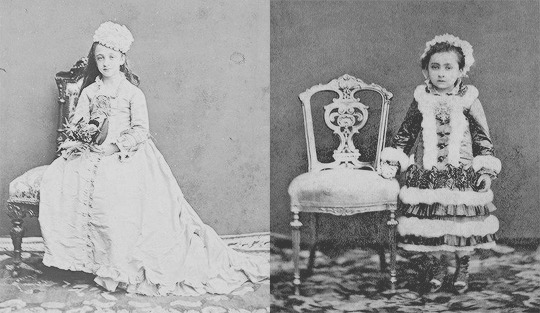
Nazima Sultan in 1876 and Naime Sultan in 1882
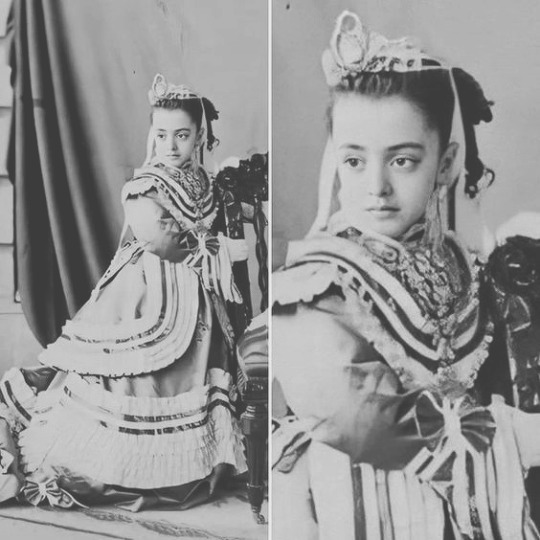
Saliha Sultan in the 1870s
In this period [1867], the young ladies and young girls had completely abandoned the old dresses with three tails or trains and the baggy pants underneath; fashion now demanded shirts with a single train which was caught up and attached to the belt – there were now petticoats instead of şalvars or the baggy pants previously worn. The headdresses had also changed with the times and now usually matched the costumes; there were earrings with jewels, medallions and elaborate hairstyles, garnished with precious stones. — Leyla (Saz) Hanımefendi, The Imperial Harem of the Sultans. Daily Life at the Çıragan Palace During the Nineteenth Century
As for outerwear:
Women changed the thicker cloth they had traditionally used for their feraces (long flowing outer garments) for a much thinner material. They changed their yellow boots of morocco leather for shoes with trimmings of imitation gold thread, which they wore with thin, white socks. They began to use thinner veils and they turned covering themselves into a method for making themselves more alluring, a trend appreciated by Ali Rıza Bey, who commented that ‘the veils of our women, which were a means of ornamenting the face rather than concealing it, became finer. How charming the colourful feraces looked! And these finer veils were unable to obscure the beauty [behind]’. — Ebru Boyar, Kate Fleet - A Social History of Ottoman Istanbul
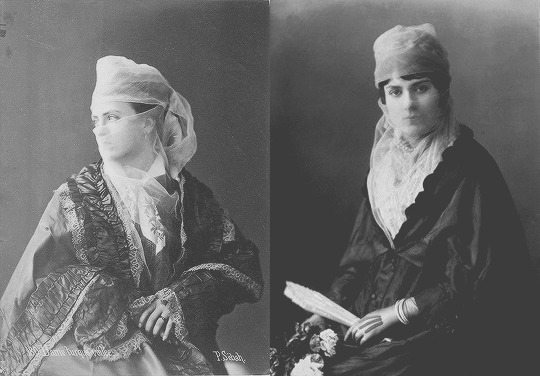
These photographs are great examples of just how fine veils had become. They basically did not hide any feature and this was a problem for conservatives (and sultans as well):
The çarşafs had become merely ordinary dresses, the feraces had turned into sleeveless capes, the veils had become too thin. [Abdülhamid II] issued an order that this should not occur. Further, women were not to wear coats or short, tight-waisted jackets which imitated military styles — Ebru Boyar, Kate Fleet - A Social History of Ottoman Istanbul

In the photograph above you can see a western dress underneath the ferace and several rows of what seem to be pearls.
In the XIX century, women (especially wealthy women of course) began to go out more, especially to pleasure gardens or at the Bosphorus shore. This meant that new accessories began to be used, among them the parasol. As pleasure gardens (ie. parks) were public places, men and women could see each other in these occasions:
A parasol in the rowing boat! It explains what the person wants to say. For example, if it is bent a little to one side, it means ‘I am annoyed with you’, if it is bent over further, ‘I am really angry’, if it completely covers the face, it means ‘you will not see my face again’, ‘I don’t want to see you, have you still not understood?’, if it swings hard from right to left, it signifies ‘don’t stay, pass by’, ‘return, go’, if it falls slightly to the front, it is in the place of a greeting, ‘welcome, sir’, if it falls a lot, ‘my heart has beaten again’, if it goes to the back, it means ‘oh!’, if it leans all the way over backwards, ‘what a state I am in, see me and have pity!’, if it is held to the side, ‘oh, how fine, what happiness this is!’, if it is opened and closed, it means ‘not tonight, tomorrow’, if it is closed and stays so, ‘we will make an appointment for the following day — Ebru Boyar, Kate Fleet - A Social History of Ottoman Istanbul
Men too had secret gestures:
making signs with the eyes and eyebrows, winking one eye, making as if wiping your face with a handkerchief, smelling the handkerchief with which you have just wiped your face, sighing deeply, and placing your hand over your heart. Placing your hand on your temple and half-closing then closing your eyes means ‘I am dying for you’, unbuttoning of one or two buttons of the waistcoat means ‘my heart is palpitating, I cannot bear this beating’. If you have a cigarette in your mouth, even if it is newly lit, and you take it from the corner of your mouth and hurl it away, this is because women do not like addiction to tobacco any more than its smell. To call over a beggar and give him a few coins demonstrates your compassion and generosity. To be busy looking at the posters outside Manakyan’s theatre is a sign of liking romantic themes such as La Dame aux camelias or Countess Sara. — Sermet Muhtar Alus, 30 Sene Evvel İstanbul. 1900’lü Yılların Başlarında Şehir Hayatı
... clothing made in European fashion, top hats, fancy canes, pet dogs, piano lessons, French language lessons, operas, dances, and balls, to the eventual employment of Western literary forms such as the novel, short story, and newspaper and the print culture it introduced, which had profound effects in creating new visions of Ottoman society and the individuals living within it. These literary forms constructed a new image of an Ottoman as a refined man "introverted, very sensitive, knowledgeable in Western music and literature, conversant in a Western language, positivist, attributing value to human beings, and subscribing to a Western style of life" — Fatma Müge Göçek, Rise of the Bourgeoisie, Demise of Empire; Ottoman Westernization and Social Change
Of course the same craze invested the Palace. Sisters Fatma and Mediha are clearly wearing European gowns and accessories:

Fatma Sultan around 1870 and Mediha Sultan in 1888
In the photograph below we can see Refia Sultan dressed exactly like a European woman in 1865. 1865 is very early but she was very interested in everything that came from Europe.

I was not able to identify these people but they're clearly from the Ottoman empire:

the lady is particularly interesting because not only is she wearing a European-style tiara but she seems to be also wearing the Order of the Charity (the white sash) 1st class, which was usually awarded to princesses.
Here we have sisters Hatice, Fehime and Fatma (all daughters of Murad V). The European style of their clothes and accessories is pretty evident.
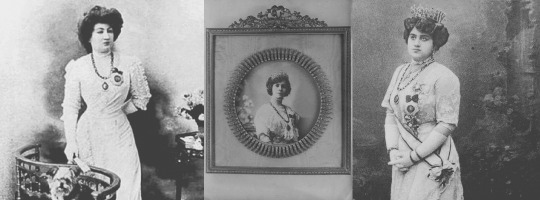

Rukiye Sabiha Sultan on her wedding day in 1921
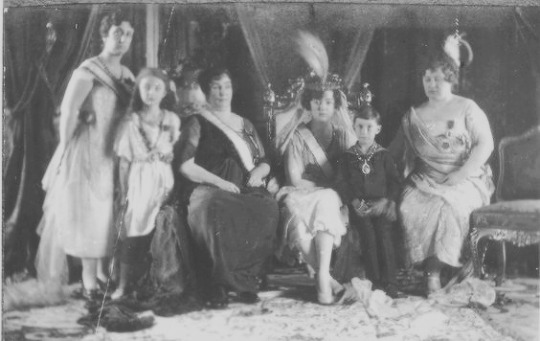
other photo of Rukiye Sabiha Sultan’s wedding
So... yeah, by the fall of the empire clothes were completely European.
#anon#ask post#ask: ottoman history#ottoman fashion#ottoman photos#late ottoman empire#nazima sultan daughter of abdulaziz#naime sultan daughter of abdulhamid ii#saliha sultan daughter of abdulaziz#fatma sultan daughter of abdulmecid i#mediha sultan daughter of abdulmecid i#refia sultan daughter of abdulmecid i#hatice sultan daughter of murad v#fehime sultan daughter of murad v#fatma sultan daughter of murad v#rukiye sabiha sultan daughter of mehmed vi
203 notes
·
View notes
Text
Sermet Muhtar Alus / Mektebi Hukuk'taki edebiyat kapı yoldaşlarının şeyhi Mithat Cemal Bey’di

Eski İstanbul yazarı Sermet Muhtar Alus, 1906 - 1910 yılları arasında Mektebi Hukuk'ta öğrenciydi. Alus, o dönemi anlatan ve 1932 yılında yayınlanan yazısında, edebiyat ve basın tarihine geçecek yazarlar ve öğretim üyeleri ile ilgili çizgilerin yanı sıra II. Abdülhamit döneminin gölgesi yer alıyor.
Eski bir yazımda da dediğim gibi ismi Mektebi Hukuk, içi Babil Kulesi gibi bir yerdi.
Karınca yuvası gibi kaynayan koridorlarında adım atılmaz, tıklım tıklım dershanelerinde oturacak yer bulunmaz, panayır meydanına benzeyen set bahçesinde, yekdiğere yabancı yabancı nazarlarla bakışılırken, gitgide göz aşinalığı artmaya, yavaş yavaş teklif tekellüf kalkmaya başlardı.
Hakkı bey (sonra sadrazam olan) idare teşkilatımızın tarihine girişip, bir virgül yeri şaşırmayarak, öhö bile demeyerek edebiyat yapmaya koyulunca, derhal gözler parlar, tavırlar değişir, kimlerin edebiyatçı olduğu, kimlerin oralı olmadığı o dakika sezilmeye başlardı.
Bir müddet daha bu minval üzerine gidildikten sonra Şuayıp merhum, Ormanlar bahsinde, zümridin çemenler, nefti gölgeler, şakrak bülbüllerden tutturdu mu artık bıçak kemiğe dayanır, derunu kalp taşmaya başlar: Fikret'in noktai nazarınca... Uşşakizade diyor ki... Faik Âli'deki itilâ ve haşmeti eda... gibi kelimeler ağızlardan dökülür, çok geçmeden ahbap ve samimi olunuverirdi.
Artık gelsin, köşede, bucakta edebiyat bahisleri, şiirler, nesirler, tenkitler, dedikodular...
Devrin sonlarına doğru, edebiyatın büsbütün gırtlağı sıkılmış, matbuatta şiir, hikâye, roman tamamen menedilmişti. Gençler, eserlerinin neşri ihtimalini, yüzde bir hatıra getirmedikleri halde gene çalakalem meşgul olmaktan geri kalmıyorlardı.
O zaman, Mektebi Hukuk'taki edebiyat kapı yoldaşlarının şeyhi Mithat Cemal beydi.
Çok yakışıklı siması ile, kibar ve nazik tavrı ile, doktora imtihanlarına gelip gittikçe Vefa İdadisi'nden beri şair olduğunun bahsi geçer, eski arkadaşı Sait Hikmet merhum, ezberinde olan bazı şiirlerini ve nüktelerini tekrarlardı.
Set bahçeden seslensen cevap verecek kadar yakında oturan Tahsin Nahit merhum, tıraşını olup, bıyıklarını kırpıp (İstanbul içinde ilk bıyık kesenlerdendir ve hepimize kıdemi derkârdır) mantarlı fesini başına, Civelekyan dikişi paltosunu sırtına, Fransızca Antoloji kitabı ile şiir defterini cebine koydu mu, ikinci ile üçüncü ders arasında mektebi boylar, durmadan anlatır, güler, O Kadın ve Büyükada'yı terennüm eden yeni şiirlerini okurdu. İbrahim Alâettin bey, "Söz gümüş ise sükût altındır" meselinin modeli gibi, edip, mütevazı, sessiz, sedasız, hep sami vaziyetinde bulunurken günün birinde bir şiirini okuyuverdi. O özlü ve hisli lisanı ile parmakları ağızda bırakarak derhal en baş safa çıktı.
Arkadaşları arasında en genç, en hararetli ve en velûtlardan biri de Mehmet Behçet beydi. O günlerin bazı ilhamları Erganun'da mutlaka vardır.
Şimdi felsefe mütehassısı ve muallimi olan Mustafa Namık bey, o zamanlar şiir yazar, daima yeni yeni sonelerini okurdu.
Bir âşıkı şuridedil hal ve reftarında bulunan Sakallı Rifat beyin ise ahlı, uflu şiirleri dilinden düşmez, genç çehresindeki ipek sakalı ile, naümit, meyus, mustarip bir âşıkı andırırdı.
O tarihlerde şiirle müteveggil olan olan Köprülüzade Fuat beyle Mehmet Ali Tevfik bey de mektebe dahil olmuşlar, fakat söylediğim gruba katılmamışlardı. Grubun nesir yazanlarına gelince, en başta sayılan Sait Hikmet merhumdu. Onun nelerde neleri vardı: Küçük hikâyeleri, fantezi tercümeleri, mizahî mecellesi, hatta bir de, ileride neşri musammem (1) Tarihi Hukuk'u...
Zekâ ve esprisine payan olmaz, Haydar efendinin binlerce sayfalık Mecelle şerhini bir kere devretti; lâtife ve nüktelerine emsal bulunmazdı. Şimendifer tarifesini, bir iki kere gözden geçirince ezberine alır, zihnine nakşeder, iki göz arasında da irticalen ne mısralar söylemezdi.
Ahmet Süreyya bey (Şimdi Aksaray mebusu) zekâvette ustura gibi keskin kalem ve mantıkta kuvvetli, talâkat ve hitabette ise yekta idi.
Tığ gibi bir delikanlı olan Suphi Nuri bey, gür sesi ile güzel nesirlerini dinletir, İbrahim Necmi beyin geniş nasiyesi ve parlak gözleri, edebiyat ve lisandaki kuvvetli vukufunu bar bar bağırır, Bürhanettin beyin (O zaman Felekliği yok) gerek söz, gerekse yazıdaki pırıl pırıl zekâsı cümlece yad ve tezkâr olunurdu.
Geçen sene Bursa'da merhum olan N. Behçet, ince uzun boyu, kıvrım kıvrım saçları, solgun benzi ile sanki bir şibih filozoftu. Hayatı, dürbünün ters tarafı ile gören yazılar yazar, onları en samimi bir iki arkadaşına gösterirdi.
Bir aralık mektebe devam edip aramızda bulunan Ziya Şakir Bey (Abdülhamid'in son günlerini yazan), haftada bir çıkan Hanımlara Mahsus Gazete'nin sermuharrirliğini deruhte etmişti. Sait Hikmet, Tahsin Nahit, Mehmet Behçet, N. Behçet, Rakımülhuruf (2), kadın imzası ile ve tercüme kaydı ile, semtleri ve eşhas isimlerini frenkleştirerek bazı yazılar yazıp dururduk. Bu, şimdikinin aksi olarak, bir nevi Türkçe'den Fransızca'ya adapte idi.
Şu menkıbeyi de ilave ederek tamamlayayım:
Bir gün, bahçedeki çamın altında, sekiz, onumuz başbaşa vermiş, etrafı kollaya kollaya, çene çalıyoruz.
*** telaşlı telaşlı geldi:
- Haberiniz var mı? Ömer Naci Avrupa'ya kaçmış! demesin mi?
Herkeste şafak attı; hoşafın yağı kesildi; etekler tutuştu.
Etraf dolu; kalabalığın arasına hariçten birkaç işgüzarın sokulması ihtimali yüzde yüz.
Haftalarca bunun tasasını çektik ve dut yemiş bülbüle döndük.
(1) neşri musammem: yayınına karar verilmiş olan
(2) Râkım-ül hurûf: Eserin muharriri, müellifi. Eskiden bir şey yazanlar, tevazu yoluyla çok defa kendilerinden böyle söz ederdi.
(Servet Muhtar / Edebiyat gazetesi / 24 Haziran 1932)
0 notes
Text
İstanbul’da Grip, 1918-1919, Gazeteci, yazar Sermet Muhtar Alus anlatıyor
30 Ocak 1941 tarihli Akşam gazetesinde yayımlanan Sermet Muhtar Alus imzalı “İstanbul’da İnfluenza” başlıklı yazı:
“O zamanlar, her sene kara kışta bir veya iki kere başı vurup lâakal on beş gün yatak döşek serilmek şarttı. Adı İnfluenza’ya tutulmak. Paçavra hastalığı da derledi ki sebebi, vücudu paçavraya çevirişi. (O vakit grip kelimesi ortada yok.)
Elâ gözlümün çıka gelişi en ziyade…
View On WordPress
0 notes
Photo
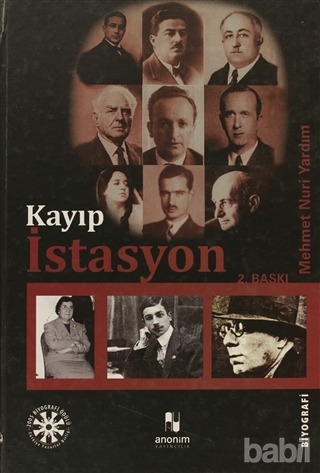
Kayıp İstasyon Ciltli Abdülhak Şinasi Hisar, Hamamzâde İhsan, Ercüment Ekrem Talu, Sermet Muhtar Alus, Osman Cemal Kaygılı, Refi Cevat Ulunay, Nihad Sâmi Banarlı, Sofi Huri, Ziya Osman Saba, Safiye Erol, Nahit Sırrı Örik ve Bahaeddin Özkişi...
#e book#e book indir#e kitap indir#Kayıp İstasyon Ciltli babil#Kayıp İstasyon Ciltli dr#Kayıp İstasyon Ciltli e kitap#Kayıp İstasyon Ciltli fiyat#Kayıp İstasyon Ciltli hepsiburada#Kayıp İstasyon Ciltli idefix#Kayıp İstasyon Ciltli indir#Kayıp İstasyon Ciltli kitapyurdu#Kayıp İstasyon Ciltli konusu#Kayıp İstasyon Ciltli oku#Kayıp İstasyon Ciltli özet#Kayıp İstasyon Ciltli pdf#Kayıp İstasyon Ciltli pdf indi#Kayıp İstasyon Ciltli pdf indir#Kayıp İstasyon Ciltli pdf oku#Kayıp İstasyon Ciltli pdf özet#Kayıp İstasyon Ciltli pdf satın al#Kayıp İstasyon Ciltli satın al#Kayıp İstasyon Ciltli yazar#kitap indir#kitap oku#kitap özeti#kitap özeti indir#pdf kitap#pdf kitap indir#pdf kitap oku
0 notes
Text
Aydede 1949 -3 Kitabı pdf indir pdf indir
Aydede 1949 -3 Refik Halid Karay’ın sürgünden döndükten sonra 8 Mayıs 1948 tarihinde yeniden yayımlamaya başladığı Aydede dergisi 1 Ekim 1949 tarihli 125. sayıya kadar varlığını sürdürmüştür. 1922’de 90 sayı çıktıktan sonra derginin başyazarı ve kurucusu Refit Halid’in yurtdışına gönderilmesiyle Aydede’nin ilk dönemi de kapanmış oluyordu. İlk yayınından daha uzun ömürlü olmasına rağmen Aydede’nin İkinci dönemi ilk dönemi kadar popüler olamamıştır. Adalet Cimcoz, Fikret Adil, Cemal Refik, Ercüment Ekrem Talu, Orhan Murat Arıburnu, Fazıl Ahmet Aykaç, Recep Bilginer ve Sermet Muhtar Alus Aydede’nin ikinci döneminde yazılarıyla yer almış, Turhan Selçuk ise derginin kapak karikatürlerine can vermiştir. 1948-1949 yılları içerisinde yaşanan politik gelişmeler derginin siyasal hicvinin belirlenmesinde ön plana çıkmıştır. Aydede’nin ikinci dönemi ile birlikte eski muhalif mizah yazarı kimliğine yeniden kavuşan Refik Halid güçlü, incelikli ve sivri mizah anlayışı ile muhalif duruşunu yansıtmaya devam etmiştir. Türk mizahının doruk noktası Aydede, 3 ciltlik bir çalışmayla ilk defa okur karşısına çıkıyor.
Aydede 1949 -3 Kitabı pdf indir pdf indir oku
#Aydede 1949 -3 kitabı pdf indir#Aydede 1949 -3 pdf oku#Aydede 1949 -3 ücretsiz indir#Aydede 1949 -3 ücretsiz pdf indir#Genel
0 notes